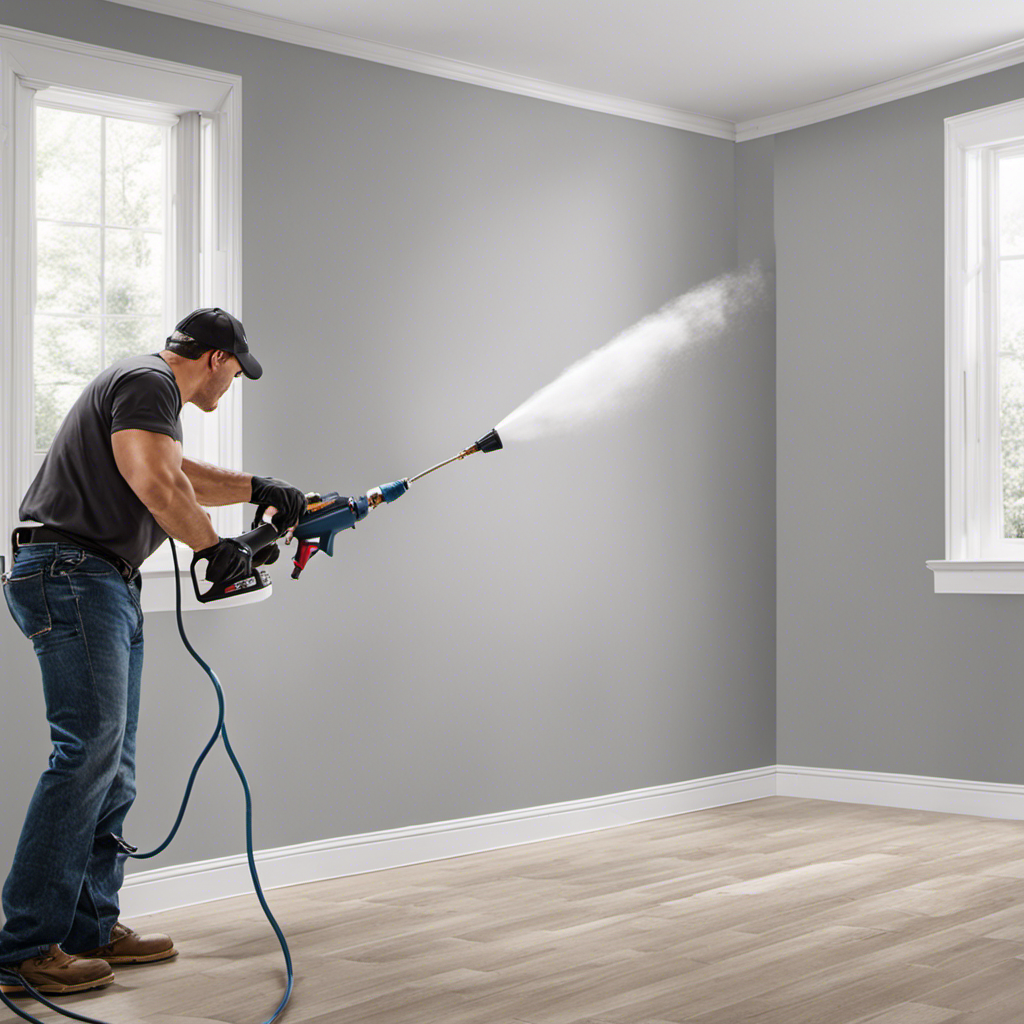Spray painting, a commonly used method for coating various surfaces, presents considerable risks that can affect the well-being of workers. Recent data reveals that more than 100,000 employees in the United States are exposed to hazardous substances while spray painting.
To mitigate these risks, it is crucial to implement safety measures and ensure compliance with Occupational Safety and Health Administration (OSHA) standards. This article will delve into the various hazards of spray painting, discuss essential safety measures, and highlight the importance of compliance to protect workers and maintain a safe working environment.
Key Takeaways
- Exposure to toxic fumes and chemicals can cause respiratory issues and long-term health problems.
- Proper ventilation and personal protective equipment (PPE) such as goggles and respirator masks are essential in controlling the hazards of spray painting.
- Flammable materials should be stored safely and away from ignition sources to prevent fire hazards.
- Comprehensive training on safe operating procedures should be provided to minimize physical injuries and ensure compliance with OSHA standards.
Understanding the Hazards of Spray Painting
Spray painting poses various hazards, such as exposure to toxic fumes and chemicals, which can cause respiratory issues and long-term health problems. Preventing occupational hazards and ensuring compliance with safety standards is crucial in mitigating these risks.
It is essential to understand the potential dangers associated with spray painting, including volatile organic compounds (VOCs) present in paints that can lead to respiratory issues, eye irritation, and dizziness. Skin contact with hazardous substances in certain paints and fire hazards from flammable spray paints are also concerns.
To control these hazards, proper ventilation in the workspace, use of personal protective equipment (PPE) such as goggles and respirator masks, and safe storage and disposal of flammable materials are necessary. Practicing good housekeeping and adhering to Occupational Safety and Health Administration (OSHA) standards are additional measures to ensure a safe spray painting environment.
Exposure to Toxic Fumes and Chemicals
Exposure to toxic fumes and chemicals can result in respiratory issues, eye irritation, dizziness, and long-term health problems for individuals engaged in spray painting tasks.
The inhalation of volatile organic compounds (VOCs) found in paints can lead to serious respiratory problems. Additionally, the chemicals present in certain paints pose a risk of skin contact, which can cause irritation and other adverse effects.
Furthermore, there is a potential for fire hazards due to the flammable or combustible nature of spray paints. To mitigate these risks, it is crucial to ensure proper ventilation in the workspace, use personal protective equipment (PPE) such as goggles and respirator masks, and store flammable materials safely.
Adhering to Occupational Safety and Health Administration (OSHA) guidelines and providing comprehensive training on safe operating procedures are essential in preventing exposure to toxic fumes and chemical hazards.
Volatile Organic Compounds (Vocs) in Paints
Volatile organic compounds (VOCs) found in paints can have detrimental effects on respiratory health. These compounds are released into the air as gases when paint is applied and can contribute to indoor air pollution. VOC exposure can cause issues such as irritation, dizziness, and long-term problems.
To address this, reducing VOC emissions is crucial. Paint manufacturers have been working to develop low-VOC or zero-VOC paints that emit fewer harmful chemicals. Long-term health effects of VOC exposure include increased risk of respiratory illnesses, such as asthma, as well as potential damage to the liver, kidneys, and central nervous system.
To minimize the risks associated with VOC exposure, it is important to prioritize the use of low-VOC paints, improve ventilation in painting areas, and follow proper safety protocols.
Risk of Skin Contact With Hazardous Substances
Wearing appropriate protective clothing is essential to minimize the risk of skin contact with hazardous substances during the painting process. Skin protection is crucial in preventing the absorption of harmful chemicals and reducing the risk of skin irritation, burns, or other adverse reactions. To emphasize the importance of skin protection, here is a table outlining the types of protective clothing that should be worn during spray painting operations:
| Type of Clothing | Purpose | Examples |
|---|---|---|
| Coveralls | Full-body protection | Disposable coveralls, chemical-resistant coveralls |
| Gloves | Hand protection | Nitrile gloves, neoprene gloves |
| Boots | Foot and ankle protection | Chemical-resistant boots, steel-toe boots |
| Apron | Additional protection for torso | Chemical-resistant apron |
Fire Hazards From Flammable Spray Paints
Flammable spray paints pose a significant risk of fire hazards in the workplace. To prevent accidents and ensure a safe working environment, it is crucial to implement fire prevention techniques and practice safe handling of flammable materials.
Here are four key measures to consider:
-
Store flammable materials safely: Keep spray paints in designated areas away from ignition sources and ensure proper ventilation to minimize the risk of fire.
-
Use proper ventilation: Implement exhaust fans or open windows and doors to maintain airflow and reduce the concentration of flammable vapors in the workspace.
-
Handle flammable materials with care: Follow safe operating procedures when using spray paints, including avoiding open flames or sparks and using appropriate containers for storage.
-
Provide comprehensive training: Educate employees on the hazards associated with flammable spray paints and train them on proper handling techniques and emergency procedures.
Physical Injuries During Spray Painting
Slips and falls are common physical injuries that can occur during spray painting tasks if the work area is not kept clean and free of clutter. Implementing safety training and taking preventive measures can help reduce the risk of such accidents. One way to ensure a safe work environment is by conducting regular housekeeping practices. This includes keeping the work area tidy and organized, removing any tripping hazards, and promptly cleaning up any spills or debris. Additionally, providing comprehensive training on safe operating procedures for spray painting tasks can help employees understand the importance of maintaining a clean and clutter-free workspace. By emphasizing the importance of safety and implementing preventive measures, businesses can minimize the occurrence of slips and falls during spray painting tasks.
| Tips for Preventing Slips and Falls during Spray Painting |
|---|
| Keep the work area clean and clutter-free |
| Promptly clean up any spills or debris |
| Conduct regular housekeeping practices |
Controlling the Hazards
One effective method for reducing the risks associated with spray painting is ensuring proper ventilation in the workspace. This can be achieved through the use of exhaust fans or by opening windows and doors. Proper ventilation helps to control exposure to toxic fumes and chemicals, preventing accidents and long-term health problems.
Additionally, it is important to use personal protective equipment (PPE) such as goggles and respirator masks. These items further minimize exposure to harmful substances.
Proper storage of flammable materials is crucial in preventing fire hazards. Adherence to local regulations for disposal of leftover paint and cleaning solvents is also important.
Good housekeeping practices, such as keeping the work area clean and clutter-free, help to reduce tripping hazards.
Proper Ventilation in the Workspace
Proper ventilation in the workspace significantly reduces the risks associated with spray painting by controlling exposure to toxic fumes and chemicals. Implementing proper ventilation techniques is crucial to maintaining a safe and compliant working environment.
By utilizing exhaust fans or opening windows and doors, the circulation of fresh air is increased, helping to remove hazardous fumes and maintain air quality. The benefits of proper ventilation extend beyond protecting the health of workers. It also reduces the risk of fire hazards by removing flammable or combustible vapors from the area.
Additionally, proper ventilation helps prevent the buildup of volatile organic compounds (VOCs) in the air, which can cause respiratory issues and long-term health problems. By prioritizing proper ventilation, businesses can ensure the safety and well-being of their employees while complying with regulatory standards.
Personal Protective Equipment (Ppe
Wearing goggles and a respirator mask is essential for protecting the eyes and respiratory system from harmful chemicals and fumes during spray painting tasks. To ensure compliance with OSHA standards and minimize occupational hazards, the following safety measures must be implemented:
-
Provide comprehensive training: Employees engaged in spray painting tasks should receive proper training on safe operating procedures, including the correct use of personal protective equipment (PPE) and adherence to OSHA guidelines.
-
Adhere to OSHA standards: It is crucial to familiarize oneself with OSHA guidelines for spray painting operations and ensure compliance with respiratory protection and ventilation system design requirements.
-
Use appropriate PPE: Goggles or safety glasses should be worn to protect the eyes from splatters or overspray, while a respirator mask designed for filtering out harmful chemicals should be used to safeguard the respiratory system.
-
Ensure OSHA compliance: By following OSHA standards, such as providing proper training, adhering to industry-specific regulations, and planning and preparing for spray painting projects, a safe working environment can be maintained.
Safe Storage of Flammable Materials
After discussing the importance of Personal Protective Equipment (PPE) in spray painting tasks, the next critical subtopic focuses on the safe storage of flammable materials.
Safe handling and fire prevention are paramount when it comes to the storage of these substances. To prevent accidents and maintain a compliant working environment, it is crucial to store flammable materials safely and away from any potential ignition sources.
This can be achieved by utilizing approved storage cabinets or containers specifically designed for flammable substances. These cabinets should be well-ventilated and kept in areas that are not prone to extreme heat or direct sunlight.
Additionally, it is essential to ensure proper labeling and segregation of flammable materials to minimize the risk of accidental exposure or ignition.
Proper Disposal of Paint and Solvents
To ensure a safe and environmentally-friendly workplace, it is important for workers to follow proper procedures for disposing of paint and solvents. Failure to do so can have significant environmental impacts and pose health hazards.
Here are four key considerations when it comes to proper disposal methods:
-
Separate and store paint and solvents in designated containers to prevent leaks or spills that can contaminate soil and water sources.
-
Dispose of paint and solvents through approved waste management facilities or recycling centers to minimize environmental harm.
-
Follow local regulations and guidelines for handling and disposing of hazardous materials to ensure compliance and prevent legal implications.
-
Educate and train employees on proper disposal methods to promote responsible and sustainable practices within the workplace.
Practicing Good Housekeeping
Keeping the work area clean and organized is essential for preventing accidents and maintaining a safe environment. When it comes to spray painting, practicing good housekeeping is crucial in preventing slips and falls.
By keeping the work area clean and clutter-free, the chances of accidents can be significantly reduced. This includes regularly cleaning up any spills or drips, removing any debris or obstacles, and ensuring that all equipment and tools are properly stored when not in use.
Additionally, it is important to establish clear pathways and designated areas for walking and working to minimize the risk of tripping or falling. By implementing these housekeeping practices, workers can create a safer work environment and reduce the potential for injuries during spray painting operations.
Reviewing Safety Measures
Regularly reviewing and implementing safety measures is essential in creating a secure work environment for spray painting tasks. To ensure the safety and well-being of employees, it is crucial to follow respiratory protection guidelines and prioritize proper training.
Here are four key points to consider:
- Wear goggles or safety glasses to protect the eyes from splatters or overspray.
- Use a respirator mask specifically designed for filtering out harmful chemicals.
- Keep the work area clean and clutter-free to prevent accidents and falls.
- Adhere to Occupational Safety and Health Administration (OSHA) standards and familiarize yourself with their guidelines for spray painting operations.
Eye Protection and Respirator Masks
Wearing goggles or safety glasses and using a respirator mask specifically designed for filtering harmful chemicals are important precautions to take when engaging in spray painting tasks.
Eye protection standards require the use of goggles or safety glasses to protect the eyes from splatters or overspray that can cause serious injuries.
Additionally, a respirator mask is crucial for filtering out harmful chemicals present in spray paints. The effectiveness of a respirator mask depends on its ability to properly filter and remove hazardous particles from the air.
It is essential to choose a mask that meets the necessary safety standards and provides adequate protection.
Frequently Asked Questions
Are There Any Specific Regulations or Guidelines for Storing Flammable Materials Used in Spray Painting?
There are specific regulations and guidelines for storing flammable materials used in spray painting. These regulations aim to prevent physical injuries during spray painting tasks.
It is important to store flammable materials safely and away from ignition sources to minimize the risk of fire hazards. Compliance with these regulations includes proper labeling, storage in approved containers, and keeping them in designated areas.
Following these guidelines ensures a safe working environment and reduces the potential for accidents.
What Are Some Common Physical Injuries That Can Occur During Spray Painting and How Can They Be Prevented?
During spray painting, common physical injuries can include slips, falls, and eye injuries. These injuries can be prevented by wearing protective equipment such as goggles or safety glasses to shield the eyes from splatters or overspray.
Additionally, keeping the work area clean and clutter-free reduces the risk of accidents and falls.
Following proper safety measures and using personal protective equipment are crucial in preventing these physical injuries and ensuring a safe working environment.
Can You Provide Some Examples of Industry-Specific Standards and Regulations for Spray Painting Operations?
Industry-specific standards and regulations for spray painting operations encompass a range of guidelines aimed at ensuring the safety and compliance of such operations. These standards may include specific requirements for ventilation systems, respiratory protection, storage and handling of hazardous materials, and employee training.
Adhering to these standards is crucial in preventing accidents and minimizing risks associated with spray painting tasks. Compliance with these regulations helps create a safe working environment and protects the health and well-being of employees.
How Often Should Employees Receive Training on Safe Operating Procedures for Spray Painting Tasks?
Employees should receive regular training on safe operating procedures for spray painting tasks to ensure their safety and compliance with regulations. The frequency of training will depend on the specific industry and the level of risk involved.
Safety protocols should be thoroughly explained, covering topics such as proper ventilation, personal protective equipment, storage of flammable materials, and disposal of hazardous substances. By providing comprehensive and frequent training, employers can minimize the potential hazards associated with spray painting and create a safer working environment.
Are There Any Specific Requirements for Respiratory Protection and Ventilation Systems Design Outlined by Osha?
Yes, there are specific requirements for respiratory protection and ventilation systems design outlined by OSHA.
These requirements are in place to ensure the safety and health of workers engaged in spray painting tasks.
OSHA mandates that employers provide appropriate respiratory protection, such as respirator masks, to employees when there is a risk of exposure to harmful chemicals.
Additionally, OSHA requires proper ventilation systems to be designed and implemented in workspaces where spray painting is conducted, in order to minimize the inhalation of toxic fumes and maintain air quality.
Conclusion
In conclusion, spray painting can be likened to a delicate dance between creativity and compliance. Just as a skilled dancer gracefully navigates the stage, a responsible spray painter must navigate the hazards and safety measures with precision.
By adhering to OSHA standards and employing proper ventilation, personal protective equipment, and safe storage practices, painters can create their masterpiece while ensuring their own well-being.
Remember, compliance is not a burden, but rather a partner in the graceful art of spray painting.
A seasoned painter with over 15 years in the industry, Mike transitioned from hands-on painting projects to the digital world of paint sprayers. His extensive experience gives him a unique perspective on what users truly need when it comes to painting tools. As the Editor in Chief of Paint Sprayer Zone, Mike ensures that every piece of content not only provides value but also reflects the realities of painting — the challenges, the joys, and the intricate details.










